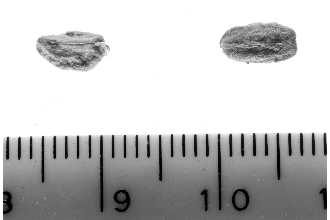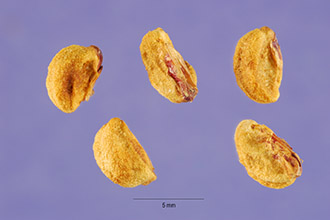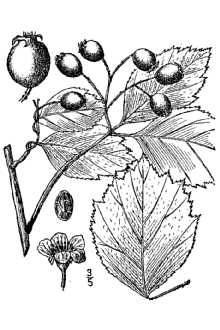Black Hawthorn
Scientific Name: Crataegus douglasii Lindl.

| General Information | |
|---|---|
| Usda Symbol | CRDO2 |
| Group | Dicot |
| Life Cycle | Perennial |
| Growth Habits | ShrubTree, |
| Native Locations | CRDO2 |
Plant Guide
Alternative Name
Douglas hawthorn
Uses
Erosion Control: Because it tolerates a wide variety of sites, black hawthorn can be planted to stabilize banks, for shelterbelts, and for erosion control along ditches and highways. Timber: Although the wood is hard and strong, it has no commercial value except for tool handles and other small items. Wildlife: It provides abundant food and cover for game birds such as the blue and sharp-tailed grouse. The mule deer, small mammals and other wildlife species feed on the leaves and twigs of young seedlings or trees. Livestock readily eats its leaves if accessible. Beautification: Ideal for biological barriers between recreational areas and physical structures.
Status
Please consult the PLANTS Web site and your State Department of Natural Resources for this plant’s current status, such as, state noxious status and wetland indicator values.
Description
It is a large shrub or small tree that can grow to thirty-five feet tall, with straight, strong but few thorns ranging from 0,5 to 1 inch long, Stems are usually clustered from the base or from a point just above the ground surface, Leaves are smooth, long, broad, dark green, shiny, and serrated at the tip, Use soil moisture sensors to measure the soil moisture of Black Hawthorn., Flowers are globe-shaped and in small clusters produced in the spring, Its fruits are dark reddish-purple to black, J,E, & Bonnie McClellan © California Academy of Sciences @ CalPhotos Distribution: Crataegus douglasii, black hawthorn, is widespread in the Pacific Northwest, from southeastern Alaska south through British Columbia to northern California,
Adaptation
Black hawthorn generally occurs on deep, moist, fine-textured soils, at lower elevations ranging from 2,200–5,400 ft. Although it will succeed in partial shade and different soil types, it grows best in full sunlight with sufficient moisture levels. It is predominantly an understory species and seldom found in pure stands. It is fire tolerant and will re-sprout and produce suckers following fire disturbance.
Establishment
Propagation from Seed or Grafting: Black hawthorn can be propagated by either seeds or grafting. To increase percent germination, seeds require acid scarification for 0.5 to 3 hours, followed by 84 to 112 days of cold treatment. Seeds are planted early in the fall, in drill rows 8 to 12 inches apart and covered with 1/4 inch of soil. Seedlings must not be kept in the nursery longer than a year. Approximate seed per pound: 22,600. Containerized trees should be planted when they are no more than eight feet tall, in the fall or spring. Balled and burlapped trees should be planted in early spring. Grafting on seedling stock of Crataegus oxyacantha or Crataegus monogyna is best carried out in the winter to early spring.
Management
Because it develops long taproot, it should not be kept in seedbeds more than one year. Pruning should be done in the winter or early spring in order to maintain a clear shoot leader on young trees and/or remove the weakest branches to allow more light to pass through. Suckers or stems arising from the roots should be removed when they become noticeable. Limited agriculture/livestock can help maintain and protect black hawthorn thickets as important source of food and cover for wildlife.
Pest and Potential Problems
Although pests and diseases seldom affect it, it is susceptible to fireblight, cedar-hawthorn rust, cedar-quince rust, leaf blight, fruit rot, and leaf spot. Cultivars, Improved and Selected Materials (and area of origin) Consult you local nurseries to choose the right cultivar for your specific landscape. Seeds and seedlings are commercially available at forest seed companies. Contact your local Natural Resources Conservation Service (formerly Soil
Conservation
Service) office for more information. Look in the phone book under ”United States Government.” The Natural Resources Conservation Service will be listed under the subheading “Department of Agriculture.”
References
Dirr, M.A. 1990. Manual of woody landscape plants: their identification, ornamental characteristics, culture, propagation and uses. 3rd ed. Stipes, Champaign, Illinois. Duncan, W.H. & M.B. Duncan 1988. Trees of the Southeastern United States. University of Georgia Press, Athens, Georgia. Elias, T.S. 1989. Field guide to North American trees. Revised ed. Grolier Book Clubs Inc., Danbury, Connecticut. Flint, H.L. 1983. Landscape plants for eastern North America. John Wiley and Sons, Inc, New York, New York. Harrar, E.S. & J.G. Harrar. 1962. Guide to southern trees. 2nd ed. Dover Publications, Inc., New York, New York. Little, E.E. 1996. National Audubon Society field guide to North American trees: Eastern region. Alfred A. Knopf, New York, New York. USDA Forest Service 1974. Seeds of woody plants in the United States. Agricultural Handbook 450. USDA, Washington, DC. USDA Forest Service 1990. Silvics of North America. Agricultural Handbook 654. Forest Service, USDA, Washington, DC. Young, J. A. & C.G. Young. 1992. Seeds of woody plants in North America. Revised and enlarged ed. Dioscorides Press, Portland, Oregon.
Plant Traits
Growth Requirements
| Temperature, Minimum (°F) | -47 |
|---|---|
| Adapted to Coarse Textured Soils | Yes |
| Adapted to Fine Textured Soils | Yes |
| Adapted to Medium Textured Soils | Yes |
| Anaerobic Tolerance | Medium |
| CaCO3 Tolerance | Low |
| Cold Stratification Required | Yes |
| Drought Tolerance | Low |
| Fertility Requirement | Low |
| Fire Tolerance | High |
| Frost Free Days, Minimum | 120 |
| Hedge Tolerance | High |
| Moisture Use | High |
| pH, Maximum | 7.5 |
| pH, Minimum | 4.8 |
| Planting Density per Acre, Maxim | 1000 |
| Planting Density per Acre, Minim | 200 |
| Precipitation, Maximum | 260 |
| Precipitation, Minimum | 16 |
| Root Depth, Minimum (inches) | 12 |
| Salinity Tolerance | None |
| Shade Tolerance | Intermediate |
Morphology/Physiology
| Bloat | Low |
|---|---|
| Toxicity | None |
| Resprout Ability | Yes |
| Shape and Orientation | Erect |
| Active Growth Period | Spring, Summer, Fall |
| C:N Ratio | High |
| Coppice Potential | Yes |
| Fall Conspicuous | Yes |
| Fire Resistant | No |
| Flower Color | White |
| Flower Conspicuous | Yes |
| Foliage Color | Green |
| Foliage Porosity Summer | Dense |
| Foliage Porosity Winter | Porous |
| Foliage Texture | Medium |
| Fruit/Seed Conspicuous | Yes |
| Nitrogen Fixation | None |
| Low Growing Grass | No |
| Lifespan | Moderate |
| Leaf Retention | No |
| Known Allelopath | No |
| Height, Mature (feet) | 15.0 |
| Height at 20 Years, Maximum (fee | 15 |
| Growth Rate | Moderate |
| Growth Form | Thicket Forming |
| Fruit/Seed Color | Black |
Reproduction
| Vegetative Spread Rate | Moderate |
|---|---|
| Small Grain | No |
| Seedling Vigor | High |
| Seed Spread Rate | Moderate |
| Seed per Pound | 21317 |
| Fruit/Seed Persistence | Yes |
| Propagated by Tubers | No |
| Propagated by Sprigs | No |
| Propagated by Sod | No |
| Propagated by Seed | Yes |
| Propagated by Corm | No |
| Propagated by Cuttings | Yes |
| Bloom Period | Mid Spring |
| Commercial Availability | Routinely Available |
| Fruit/Seed Abundance | Medium |
| Fruit/Seed Period Begin | Spring |
| Fruit/Seed Period End | Fall |
| Propagated by Bare Root | Yes |
| Propagated by Bulb | No |
| Propagated by Container | Yes |
Suitability/Use
| Veneer Product | No |
|---|---|
| Pulpwood Product | No |
| Protein Potential | Low |
| Post Product | Yes |
| Palatable Human | Yes |
| Palatable Graze Animal | Medium |
| Palatable Browse Animal | High |
| Nursery Stock Product | No |
| Naval Store Product | No |
| Lumber Product | No |
| Fuelwood Product | Low |
| Fodder Product | No |
| Christmas Tree Product | No |
| Berry/Nut/Seed Product | Yes |


